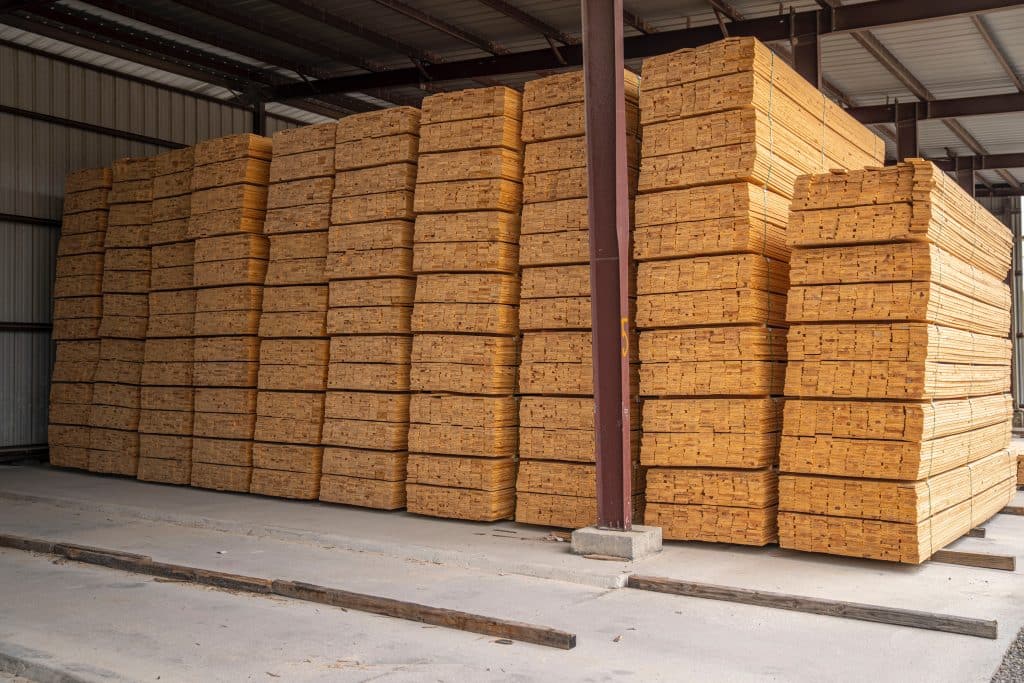Have you ever wondered what building materials the pros use to construct our world and why?
We’re diving deep into the raw materials that transform blueprints into reality. This is not an exhaustive list to be sure. We’re only looking at the top players in the field.
From stone to steel, let’s uncover the stories these materials have to tell.
What’s the Big Deal With Wood?
I’m sure by now you’ve noticed that residential homes are often wood-framed. Why is that? Why choose wood over tougher materials like masonry blocks, stone, or steel?
Well, basically for that exact reason: Toughness.
Masonry bricks, blocks, stone, and steel are generally stronger than wood but are also a lot harder to work with. Wood, on the other hand, is very forgiving. It’s flexible and easy to cut and shape and fits exactly where you need it. Not to mention, as materials prices fall in our post-pandemic world, wood is way cheaper than steel.
“But what about rot and insects” you may be asking?
Well, unless your woodwork is exposed to the elements, rot and infestation aren’t a problem.
But since you asked. For exterior construction, contractors use a special kind of “pressure-treated” wood, sometimes called Wolmonized.
That’s where lumber mills place wood in a vacuum chamber that draws out all the oxygen and moisture. They do that to make space for bug and rot-resistant preservative chemicals. The pressure-treating process doesn’t enhance wood’s structural integrity or load-bearing strength, but pressure-treated lumber will last a lifetime without the damage that insects and rot can cause.
Block, Stone, and Bricks: Building on Tradition
Beyond wood, other traditional materials like blocks, stone, and bricks have been used in construction for centuries. These resilient materials offer excellent load-bearing capabilities and resistance to the elements.
For instance, masonry blocks and stone are commonly used for foundations, walls, and other structural elements, providing strength and durability in various construction projects.
Bricks, on the other hand, have a unique place in the construction industry. Bricks are formed from clay that’s heated in a kiln. The combination of natural materials and high heat gives them their characteristic hardness and red color.
Bricks are versatile, used for structural and non-structural walls, and are famous for their aesthetic appeal in building facades. In addition, bricks are cost-effective and environmentally friendly, contributing to their widespread use in construction.
And now, let’s talk about structural plastics:
The Rise of Structural Plastics
In the construction world, plastic use is on the rise. Structural plastics, specifically, are gaining popularity due to their lightweight nature, strength, and durability. While they might not replace traditional materials like wood, concrete, or steel, they are increasingly used in various applications.
Structural plastics, such as reinforced plastic composites, can be used to construct bridges, decking, and even buildings. They offer advantages like corrosion resistance, design flexibility, and potential for translucency.
While creating more plastics isn’t environmentally responsible, recycling plastics is. Recycled plastics make great strides toward a more sustainable future of construction.
Now, moving on to a material that does some real heavy lifting in the construction world…
Concrete: Just For Walking and Driving On?
Concrete is used everywhere strength, and durability are needed, like pavements, roads, foundations, piers, columns, walls, and bridges. That’s not to say one type of concrete does all of these jobs.
Quite the contrary!
Concrete is a composite material – consisting of different ratios of water, cement, and aggregate (sand, gravel, rocks) depending on the job requirements. The specific ratios for these ingredients dictate the concrete’s workability, strength, finish, and durability.
Types of concrete range from plain/ordinary to lightweight, all the way over to high-density. And the aggregates used don’t always stop with sand, gravel, and rock. There’s glass concrete (think of the shiny or fancy concrete you’ve seen on decorative facades), fiber-reinforced concrete, and a host of other variations.
Concrete is such a cult favorite of the construction industry because of its strength, versatility, fire resistance, low maintenance, and affordability. Although concrete costs more money up-front than other building materials, the combination of low maintenance and high durability makes it cheaper in the long run.
Plus, you can 3-D print a house with it!
Why Is Steel Stealing the Show?
So we’ve got flexible, cost-effective lumber and strong and durable concrete, blocks, brick, and stone – why is steel still in the room? What does it bring to the table that other materials don’t already have in spades?
Steel shines where those others don’t. It’s got similar strength and durability to concrete in that it can withstand high loads and stresses without deformation but at a fraction of the weight. It’s impervious to pests and rot, similar to pressure-treated lumber, but it’s more predictable than organic materials ever could be due to the strict specifications under which steel is manufactured.
The strength and flexibility, paired with steel’s consistent, predictable nature, make it very useful in constructing high-rise buildings. And on that note, steel can be easily fabricated into high-rise applications.
I mean, c’mon. Have you ever seen a 40-story tall concrete building? Pretty limited in the height department, right?
Building the Future Together
As we continue to explore the world of construction, we see that both traditional and innovative materials have their unique place in the industry.
Understanding the specific roles and applications of these construction materials is key to building functional, durable, ecologically sustainable, and cost-effective structures.
So, whether you’re a seasoned professional, a budding enthusiast, or someone curious about the intricacies of the construction world, there’s always something new to learn.
If you found this post informative and want to stay updated on the latest trends and insights in the construction industry, be sure to sign up for our newsletter.
And when you’re ready, we can help you in three ways.




